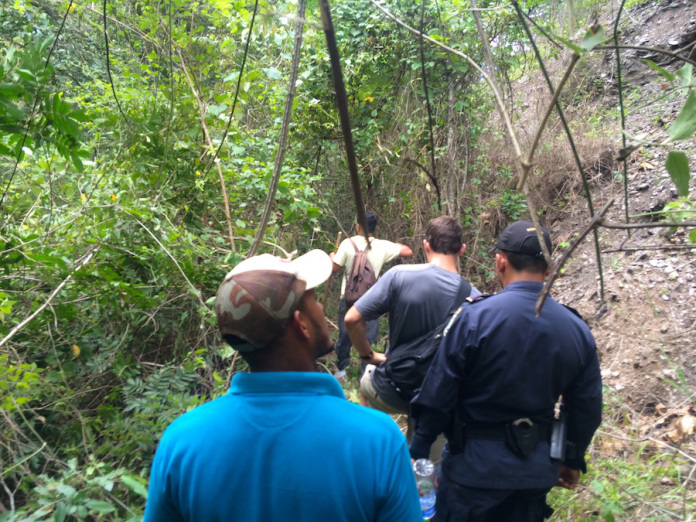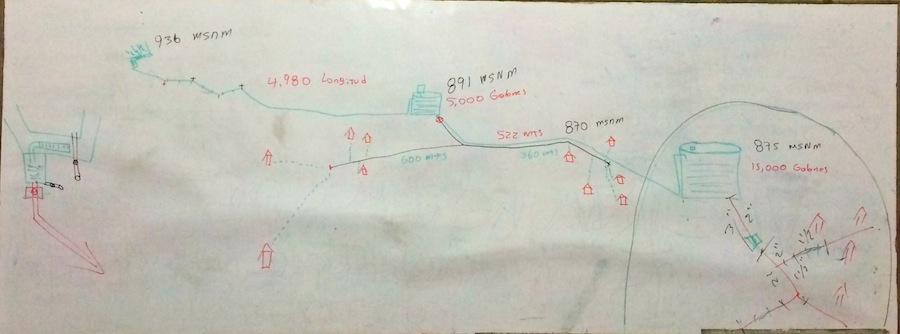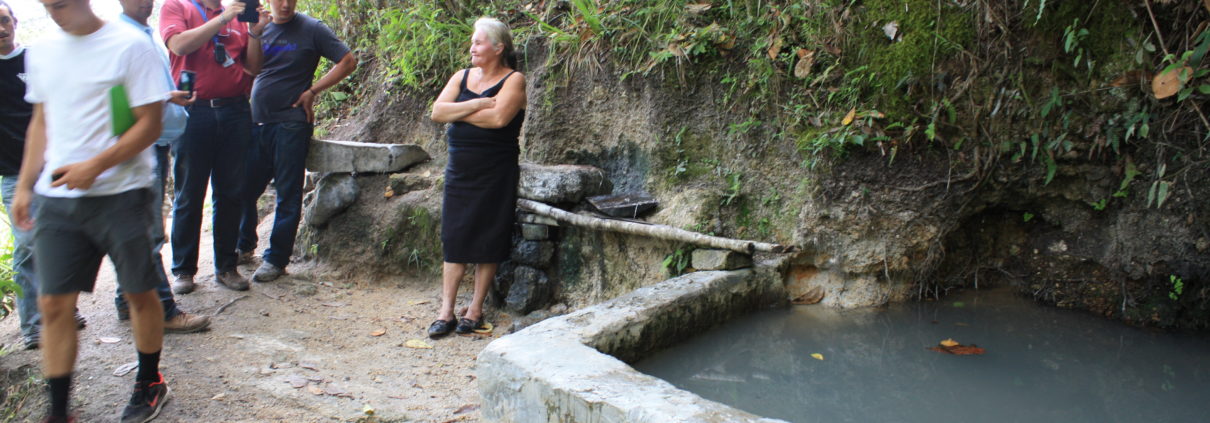Water system design in a nutshell
Journal by Aistė Manfredini
After a full day devoted to the community water system assessment in La Montañita, Honduras, Global Brigades’ Water Engineering interns and staff spent three consecutive days working in a neighboring town called Casillas. Our job entailed designing a water system from the point of the water source up to the community’s homes.
Now, when I say design, I mean starting completely from scratch with nothing but a pen, notebook, hammer, wooden stakes, permanent markers, 60 meter measuring tape, and our very own legs for transportation. We were also lucky to have a Garmin GPS device to track each waypoint, which measured the elevation of every point marked. Call me naïve, but it’s thee most brilliant GPS device I have ever used.
We spent three days “walking throughout the community” as our Water Program Coordinator Armando Osorto, would say. But realistically, it was like trekking through a semi-tropical-pinewood forest with slopes so steep that it was almost impossible to stay grounded. Pine needles and small rocks covered the mountain’s terrain, so there wasn’t much friction. Thorn bushes were everywhere. Some were as thick as a tree branch and others so thin that it was hard to avoid getting caught by their prickly thorns. Needless to say, my pants got destroyed and my arms looked like a vicious cat had attacked them. But who knows, maybe I’m being a little overdramatic.

Global Brigades water engineering staff and Casillas’ water council walk along the community’s nearby river to take measurements for a potential water system. Photo by Aiste Manfredini
Water system design: Honduran style
On the first day, we met with two locals living in the community to help us lead the way to the nearest river. Global Brigades follows a sustainable development model, so it is required that several people from the community work with GB on the water project. The model consists of sustainable methods that show community members how to design and implement a water system, while educating them on pipeline malfunctions and repairs, without relying on others to solve their problems.
The GB water engineering staff knew ahead of time that there would be a sufficient amount of water in the community’s riverbank, so they had decided that the river would be the main water source for the community’s water system, or dam, that would distribute water through polymerizing vinyl chloride (PVC) and galvanized steel pipelines. The point of the river where we had started (the potential dam) is about 3.1 miles away from the community’s empty 20,000-gallon capacity water tank, which is where the main pipeline will end.
Why is the community’s existing water tank empty? The Honduran government paid for the tank about 15 years ago, but the plumbing connected with the tank eventually broke and no one in the community knew how to fix it. According to Global Brigades water engineering staff, it is almost unreasonable to fix.
Why? There are ten houses above the elevation of the water tank that do not have plumbing, while the other 60 houses below the elevation of the tank, do. To fix the problem, and to make water available in every household, pipelines must start from the dam in the river and all the way through the community’s two tanks where water will then redistribute through smaller pipelines into to each home.
The data collection process
My internship colleague, Max Hartmann, lead the way for the water engineering team (about 13 of us) and measured every 60 meters along the river with a measuring tape. Every 60 meters, a wooden stake was placed and marked with the point’s elevation and station number for future guidance.
My job was to record every station number and elevation in a notebook, which isn’t easy when you need to hike through massive rocks and steep hills along a semi-dry river. In total, we hiked 6,682 meters, or 4 miles, and marked over 100 waypoints from the dam to the tank for the potential water pipeline. According to Armando, it will take approximately 10 Water Brigades to build La Montañita’s water system.
But the measuring process was just the beginning.
On the second day, after we had collected each pipeline measurement, we had to plug in the measurement data on a sophisticated Excel spreadsheet that was specifically formulated for pipeline engineering. We would have been clueless on the task if it wasn’t for Marco Landa, GB water engineering director, who was patient to thoroughly explain each concept and formula to someone who doesn’t have an engineering background. He’s truly thee Excel wiz.
From our collected data, we projected that the water system in La Montañita will cost $20,000. This includes all materials needed to build the dam and water pipelines, i.e., PVC and galvanized steel. At the dam, about 90 percent of the water will be used for pipelines (consumer water) and the rest will flow into the river to preserve the river’s environment.
On the third day, we returned to the community and explained that the water committee must take care of all the legal work before Global Brigades can proceed to build the water system, i.e., dam and pipelines. Legal work consists of getting permission to build pipelines through privately owned property and going to the community’s municipality office in Talanga (about an hour drive from Casillas), to provide the municipality officials with the water system design, project plan, and signed consent from landowners.

Design of the potential water system in Casillas, a small rural town in Honduras.
This process takes between two to four months for the community to complete; thus, Global Brigades will not proceed with the project or bring in Water Brigades until all of the above is settled. However, it is estimated that La Montañita will have running water in each household by the spring of 2016!
- Water system design is not an easy task to accomplish, especially in developing countries where advanced building tools are scarce.
- It takes a strong leadership team, i.e., community water council, to make water system projects efficient and last for long periods of time.
- Potable water is a resource taken for granted by many Western and Third World cultures.
- Development takes time and effort; timelines are unpromising.
- One cannot empower another unless they want to change themselves.


